羊蹄山 (Yotei-Zan)
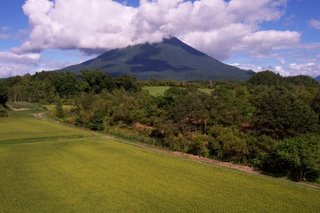 Coming off the train at Niseko, I feel like I've landed in the right place. The train station is all but deserted. Lush, green hills surround it. In the distance, the towering symmetrical cone of a volcano. To tell the truth, there's not much I know about this place. It's simply the recommendation of a shy girl at the Hakodate tourist information desk. I have no map. I ditched my guidebook 1000km away. This leaves me with one option - the old woman behind the station kiosk counter.
Coming off the train at Niseko, I feel like I've landed in the right place. The train station is all but deserted. Lush, green hills surround it. In the distance, the towering symmetrical cone of a volcano. To tell the truth, there's not much I know about this place. It's simply the recommendation of a shy girl at the Hakodate tourist information desk. I have no map. I ditched my guidebook 1000km away. This leaves me with one option - the old woman behind the station kiosk counter. She tells me that whilst she's never climbed Yotei-Zan (the name of the volcano), she's heard that there are some huts where one can stay. Taking leave of her post, she escorts me to the station attendant, who doubles up as the tourist information office. He recommends a mountain on the other side of the train line, as it's closer and has more amenities. Unfortunately, it looks like some kind of tourist resort, with prices upwards $60 per night. There's little he knows about Yotei-Zan, other than the way to get there, which he sketches for me on a local area map.
It's 2 pm when I start walking. As I've missed the bus, I have 7 km of highway before me. The town of Niseko is clean, with brand new paving, but too quiet for a place of that size. I walk into a supermarket and purchase a bottle of green tea, a block of dark chocolate and a bag of prawn-flavoured chips. My hope is that the base of the mountain will be full of the usual souveneir shops stocking everything from walking sticks to Winnie the Pooh keyrings.
Having climbed up through a winding forest road, I find that there's a camp site, an amenities block, some lodges and one vending machine. There's a map of Yotei-Zan, and indeed there's a shelter near the very crater. The mountain is 1898 meters high. I have inadequate suppiles. No wet weather gear. One thermal top in addition to a spare t-shirt. I don't have a watch, but judging by the position of the sun, it's mid-afternoon. So, I start walking.
After several hundred metres, the dark cedars thin out, and I enter a more thinly-vegetated myrtle birch forest. The undergrowth is thick, covered with something from the bamboo family that I'd never seen before. I meet nobody. As the path turns to the east side of the mountain ridge, it starts to get colder in the shade. I'm just hoping that I'll be able to come clear of the vegetation by sunset.
That is precisely what happens, 5 minutes before the sun sinks into the Pacific Ocean below. The view is gorgeous - the Sea of Japan on one side, the Pacific on the other. A half moon sits high to the east of the sunset. As the sunlight fades, the path grows steeper. I accidentally take one step to the side of the path and fall 1 metre into the undergrowth. Still, I'm hoping that my eyes will adjust to the darkness.
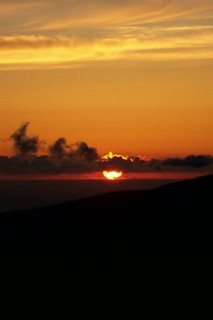
When the path starts to cross some steep lava flows, I start to get worried, as it's hard to discern where to go. Luckily, there are white dots painted on some of the rocks. At one stage I manage to fall into a hole and hurt my knee. At that point I decide that taking out my torch would be appropriate.
It is more than appropriate, as I come across a faded wooden sign indicating a turnoff for the shelter. It's not far, but when I step through the door, I only hear snoring in the dim interior. Luckily, a woman comes out of the toilet and helps me find the ranger in charge. The ranger is clearly not happy, giving me a lecture about the dangers of climbing mountains in the dark, and how it is his responsibility if anything were to happen to me. I pay him 800 yen, and spread my sleeping bag on the hard wooden floor.
Waking up is no problem - at around 4 am the whole hut is suddenly filled with the noise of people packing their bags. To my surprise, another foreigner approaches me. He's been working as a teacher for 5 years, and is climbing the mountain with his Japanese wife.
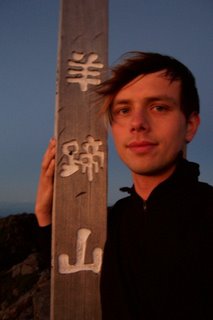
The climb up to the summit takes us up some steep lava flows, then around the rocky crater rim. I can't really see where I'm going and so I fall into another hole. It turns out that we are the first people up the mountain and I wrap myself up in my sleeping bag waiting in the cold for the sunrise. It is well worth it, as we are the only people there to see it, in addition to another Japanese couple.
Sunrise is at 04:55. I need to be in Sapporo at 12:00. Unfortunately, this leaves me with little time, and so I start running down the mountain. In no time, I've
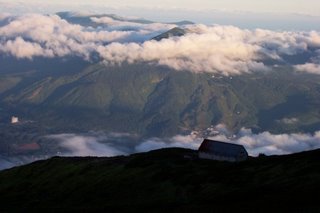 managed to lightly twist both ankles.
managed to lightly twist both ankles.Views on the way down are gorgeous, with the volcano casting a symmetrical shadow on the valley below. As I near the base of the mountain, I meet more hikers. To my surprise, 90% of them must be over the age of 60. They are well prepared, with walking sticks, hats, hiking boots and bells to ward off bears who still inhabit these parts.
It's 08:00 by the time I make it out onto paved road. It's a gorgeous morning and I enjoy the smell of potato fields. I make it to Hirafu Station by 09:00, having asked directions of local farmers. The station is little more than a wooden shack, with a 民宿 (inn) attached. I haven't seen a vending machine during all this time. Breakfast consists of yellow tomatoes purchased at an honesty stand set up by a local farmer. 100 yen. I play with the station cat. The train comes at 09:18. I get to Sapporo precisely on time.
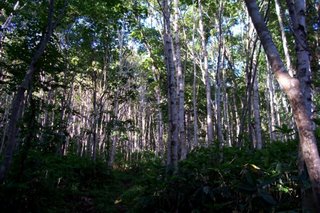
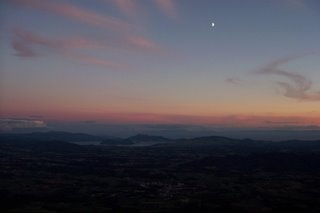
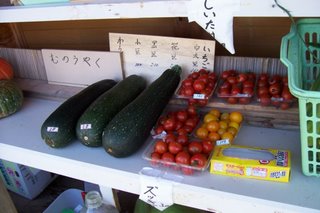


1 Comments:
great post; your last eMAIL to Pat had strange characters. Hope all is well. Happy NEW YEAR
Post a Comment
<< Home